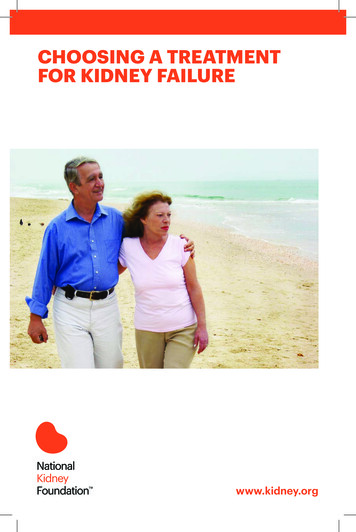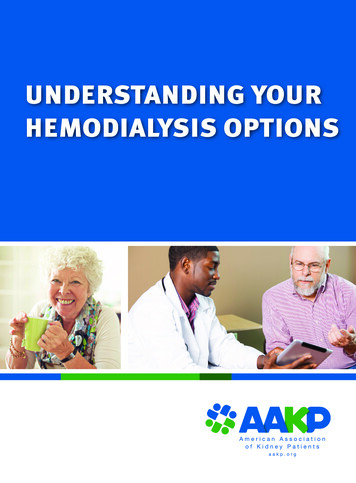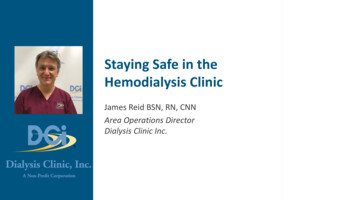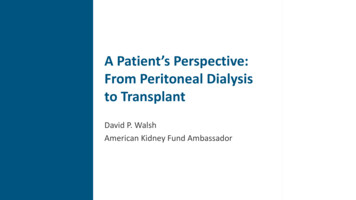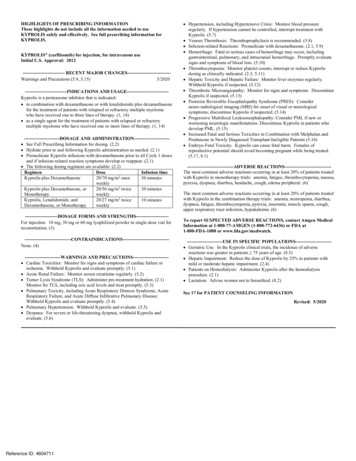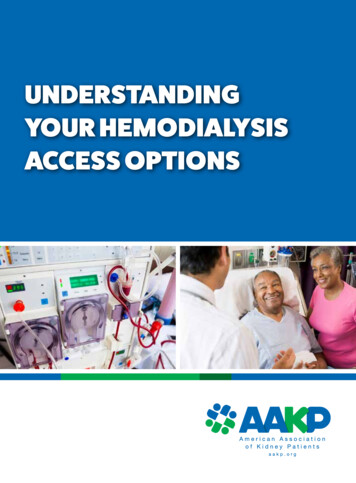
Transcription
UnderstandingUNDERSTANDINGYourYOUR HEMODIALYSISHemodialysisACCESSOPTIONSAccess Options
UNDERSTANDING YOURHEMODIALYSIS ACCESS OPTIONSTABLE OF CONTENTSYOUR DOCTORS CAN MAKE TWO KINDS OFVASCULAR ACCESS FOR HEMODIALYSIS. 2ARTERIOVENOUS FISTULA. 2ARTERIOVENOUS GRAFT. 2THE KIND OF VASCULAR ACCESS THAT“STICKS OUT” THROUGH YOUR SKIN. 3CATHETER. 3CARE FOR FISTULA AND GRAFTS. 8FEEL — LISTEN — LOOK. 9CATHETERS. 10GLOSSARY. 12AAKP would like to extend a special thank you to Dr. Ari Kramer, SpartanburgMedical Center, for his assistance in the revisions of this educational brochure.
What is a vascular access? A vascular access isa place on your body close to a vein and artery.This place on your body allows “access” to yourblood stream using two needles which connects tothe kidney “replacement” machine which allowsremoval of “bad” and return of “good” blood toyour body. The job of the kidney machine is toclean your blood. This clean blood goes back intoyour body through your vascular access. About15 tablespoons of blood is cleaned and returned(about the size of a small bottle of water) each minute of your treatment.Your vascular access is like a conveyor belt that keeps the kidney machinerunning and keeps you healthy!This brochure describes common kinds of vascular access. AAKP dividesthis brochure into two sections. The first section describes long-lastingkinds of vascular access. The second section describes short-term vascularaccess. This brochure also tells you how doctors make your vascularaccess. This brochure includes the benefits and challenges of each kind ofvascular access.AAKP hopes this brochure will help you understand more about thedifferent kinds of vascular access. After learning about vascular access,you can help your doctor decide what kind is best for you. Your doctorsmay recommend HEMODIALYSIS, to treat your end-stage kidney disease(ESKD).End stage kidney disease is a medical term meaning your kidneys don’twork well enough to keep you healthy.During HEMODIALYSIS, the artificial kidney machine pumps your bloodfrom your body to the artificial kidney through a flexible, plastic tubewhich is connected to your vascular access site. Your blood is cleanedwhile in the dialysis machine. The dialysis machine returns your cleanedblood to your body through a separate tube. When a drop of blood leavesyour body, another drop of blood comes back to your body after it iscleaned. Some people call the vascular access site “your lifeline.”
YOUR DOCTORS CAN MAKE TWO KINDS OFVASCULAR ACCESS FOR HEMODIALYSISThe first kind is completely COVERED by yourskin. The second type is a plastic tube going fromone of your large veins THROUGH your skin.The Two Kinds “Covered By Your Skin”Doctors often select which type of access isgoing to be made by using a machine called anultrasound which helps measure and “map”blood vessel sizes and flow. They use thisinformation to select the best artery and vein toconnect. You and your doctors can choose fromtwo kinds of “under-your-skin” vascular access.ARTERIOVENOUS FISTULAThe first choice of “under-yourskin” access is called an “AVF.”AVF means “Arterio-VenousFistula.” The word “fistula”means a “connection.” This optionis generally felt to be the bestchoice. This procedure can now beperformed in one of two ways.The first way is for a surgeon tomake a small surgical incisionover the artery and vein and thensew them together. The joining oftheses blood vessels is called anAVF (fistula).Until recently, surgery was theonly way to create an AVF andsometimes that could lead todelays. Now, a second way toperform this operation may beused without needing “surgery”and avoiding needing to go toMayo Clinic Foundation forEducation and Researchan operating room. This newestmethod of joining the bloodvessels is called a “percutaneous”fistula. Instead of a cut, a specialdevice is used to join the bloodvessels together through a smallneedle stick or sticks. For manypeople who can get this typeof access it is often safer andfaster. It can usually avoid a skinincision and lessen the normaldiscomfort that may occur froman “traditional” operation. Youshould ask if your doctor offersthis type of surgery.ARTERIOVENOUS GRAFTThe other kind of “under-yourskin” vascular access is calleda “graft.” This kind of vascularaccess is not a direct connectionbetween your artery and vein.Instead, doctors connect one ofAmerican Association of Kidney Patients: Understanding Your Hemodialysis Access Options2
your arteries to one of your veinsby using an artificial tube orbridge called a “graft.” The graftis an artificial blood vessel usuallymade from soft, rubbery plastic,but can be made from speciallyprepared blood vessels. A graft islike an AVF. Both are “under- theskin.” A graft is different from anAVF because a graft is an artificialblood vessel. An AVF is madeentirely from your own bloodvessels. Artificial grafts are moreprone to get plugged with clots orget infected.Both AVFs and grafts requiresome time to heal before they canbe used for dialysis treatments.The healing times vary from daysto months. AVFs take longer to“mature” and become ready to usefor dialysis.Both grafts and AVFs requireputting two needles through yourskin, into the “Under-the-Skin”vascular access. This is done forevery dialysis treatment. Oneneedle takes blood out of yourbody for cleaning. The otherneedle returns cleaned bloodback to you. Few people like thethought of having needles throughtheir skin for every dialysistreatment. But it turns out thattemporary needles are much,much safer than having a plastictube that sticks through your skin24 hours per day, 7 days per week.Anything that sticks through yourskin all the time is much morelikely to let germs (bacteria) intoyour blood stream. Infection inthe blood stream is very seriousand can require hospitalizationand can even be fatal.THE KIND OF VASCULAR ACCESS THAT“STICKS OUT” THROUGH YOUR SKINCATHETERWhen you have kidney disease,dialysis can mean the differencebetween life and death. Morethan 850 million people aroundthe world have chronic kidney3disease. In the United States,nearly 50 million patients havechronic kidney disease. There aremore than 700 thousand patientswho have end stage kidney diseaseand more 500 thousand patientsare treated with hemodialysis, andAmerican Association of Kidney Patients: Understanding Your Hemodialysis Access Options
many start dialysis using a specialtype of catheter called a tunneledcentral venous catheter.Healthcare professionals all agreethat an AVF (fistula) should be thefirst choice for a dialysis access,followed by an AVG (graft) as asecond choice. However, whenthose access types aren’t anoption, the use of a catheter forhemodialysis is necessary.A catheter is a y-shaped tubemade of soft plastic that sticks outof the skin on the neck, chest orleg. There are two openings, onefor removing your blood and theother for returning the cleanedblood to your body in the sameway as a fistula or graft. A doctoror other healthcare providerplaces the end of the catheter intoa large vein.These types of hemodialysiscatheters are known as CVC’s(central venous catheters) and aremost often used as a temporaryway to access the bloodstream tobegin dialysis treatments.Sometimes a CVC is also usedin people who have a new AVfistula or graft, but need to startdialysis before the fistula or graftis ready for use. Once the fistula is“mature,” the catheter should beremoved.In some rare cases, a catheteris used for a longer period ifthere are no other options for apermanent access such as whena patient’s blood vessels are nothealthy enough for a fistula or agraft.Dialysis patients who usehemodialysis catheters have ahigher risk of death, infection,and heart problems than patientsusing other access types and itis very important to talk to yourhealthcare provider about yourpermanent access plans.Some dialysis patients prefercatheters to other accesses,usually because catheters don’trequire needles to connect to thehemodialysis machine or becausethey believe their kidney functionwill return in a few months. It’simportant to understand why apermanent access plan is saferfor you. There are several reasonsfor this. First, part of the catheteris outside the body and so it isat high risk for infections. Clotscan form inside the openingof the catheter or form on theoutside of the catheter andblock the opening. Blood flowthrough a catheter may be at alower than the rate prescribedby your doctor which meansyour dialysis treatment will beAmerican Association of Kidney Patients: Understanding Your Hemodialysis Access Options4
incomplete or require a muchlonger treatment time to removetoxins and fluids that have builtup between treatments. Infectioncan occur even with a good bloodflow rate because catheters are atype of plastic and have no abilityto fight infection the way yourown body does. Any infectionof a catheter can injure or evendestroy the heart valves which isa very serious emergency whichcan become fatal. Catheters canseriously injure and scar theveins that drain blood to the heartwhich may cause irreversibledamage preventing futurepermanent dialysis access options.Because of these risks, youcannot safely get a catheter wet,and showering and bathing canbecome impossible.Unfortunately many peoplewho need to start unplanneddialysis or short term dialysiswill need a catheter. Also, somedialysis patients will need one iftheir fistula or graft needs to berepaired. It’s important to realizethat of the three main accessoptions, catheters are the mostprone to infection.Here are some very importantthings to remember. If you havea catheter you are 4 times morelikely to have an access related5infection than those with an AVfistula or an AV graft. Comparedwith patients with who havefistulas, those using hemodialysiscatheters have a 50 percent higherrisk of dying, a 40 percent greaterrisk of developing a major heartproblem and more than twicethe risk of developing a deadlyinfection.By avoiding catheters as an initialor ongoing dialysis access, youcan lower your risks for death,infections and heart trouble. If youmust use a hemodialysis catheter,switching to a fistula or graft canhelp you avoid life threateningcomplications and may even saveyour life.The following guidelines can helpmake all types of vascular accesswork better and work longer:Wear a Medical Alert bracelet. AMedical Alert bracelet can notifyhealth care providers you are ondialysis and the location and typeof your vascular access.Ask nurses and doctors not totake blood pressures in the armwith the graft or AVF. Ask peoplewho take your blood not to takeblood from the veins in the samearm as the graft or AVF. If theyAmerican Association of Kidney Patients: Understanding Your Hemodialysis Access Options
don’t listen to your request, youshould kindly refuse to let themtake your blood pressure or takeyour blood. Ask to speak to asupervisor if you need to. Be kindbut be firm.Pay attention to the machineduring dialysis. Your vascularaccess may not be working wellenough if the blood flow speedis too slow to allow for goodcleaning. If the pressure in thevascular access is too high (likea moving car trying to squeezethrough a tunnel that is toonarrow), the blood cleaning maynot be good enough to keep youhealthy. Ask your dialysis staffwhat the flow rate and pressure inthe vascular access should be forgood blood cleaning. By keepinginformed you can understandwhy the dialysis machine makesan alarm noise when these flowrates and pressures are not goodenough to allow a good bloodcleaning. If the alarms happentoo often or can’t be improved,then you can help make decisionsabout how the vascular accesscan be improved to allow for goodblood cleaning.American Association of Kidney Patients: Understanding Your Hemodialysis Access Options6
SUMMARY OF BENEFITS AND CHALLENGES OFTHE DIFFERENT KINDS OF VASCULAR ACCESS:AV FISTULABENEFITS Considered the best vascularaccess Less chance of infection thanother types of access Often lasts many years Fast blood flow, allows the bestblood cleaningCHALLENGES Visible under the skin on the forearmMay take weeks to months todevelopAVF placement requires longterm planning, care of arm veins,early surgery to be ready for usewhen you need to start long termdialysisMay require a catheter whilefistula heals and developsNeed to watch for bleeding afterneedles are removedSome fistulas may fail to matureor grow correctly.It’s important to get AVF surgerymonths before you need to startdialysis and as soon as possible ifyou already have begun dialysiswith a catheter.GRAFTSBENEFITS Can be easily placed like AVF’s. Predictable performance Can be used sooner aftersurgery than an AV fistula(within days to 3 or 4 weeks) If a graft stops working well,often it can be converted to anAVF further up the arm (evenif an AVF could not be placedoriginally).7CHALLENGES Increased potential for clotting Increased potential for infection Does not usually last as long asan AV fistula Survival of graft patients islower than fistula patientsAmerican Association of Kidney Patients: Understanding Your Hemodialysis Access Options
CARE FOR FISTULA AND GRAFTSFind out if your vascular accessis an AVF or a synthetic AV Graft.You need to know the directionthe blood is flowing in youraccess. You also need to knowwhich area the dialysis staff isusing for the arterial and venousneedle placements. The arterialneedle takes blood out of you. Thevenous needle returns blood toyou. You need to make sure thedialysis staff person inserts theneedles in the proper direction tothe blood flow. The staff personmust also connect the bloodlinesred to red and blue to blue.Learn how to properly hold thepatches after the staff personremoves the dialysis needle. Also,learn how to put pressure on aneedle site in case it bleeds afterdialysis. Keep an emergencysupply of gauze dressings and tapein your pocket or purse. Reapplya clean dressing if the needlesites bleed on the way home fromdialysis.If blood leaks out of a needlesite at home, apply pressureon the site with a dressingbelow the bleeding site. Call 911immediately.Wash the skin over the accesswith soap and water daily andbefore dialysis. Ask how yourskin should be cleaned before theneedles are inserted. Make certainthe staff is using proper ways toprepare your skin before insertingthe needles into the access. Ask ifyou can learn to wash and cleanyour own skin and then followwhat you are taught. Ask if youcan learn to clean your skin ANDput your own needles into yourvascular access. Thousands ofpeople place and remove theirown needles. It might sounddifficult or scary now. It won’t bedifficult or scary once you learnhow and practice with a nurse ortechnician helping you. Medicalstudies show it is better to put inand take out your own needlesthan having other people do it.If you learn to place and removeyour own needles, you will alwayshave the person who knows yourvascular access the best doing thejob . YOU!Watch for signs of infection.These may include redness,tenderness or pus, or you mightfeel a fever or chill. Cleanliness isone of the most important waysto prevent infection. Dialysis staffwill teach how to do this. Reportany signs of infection to yourdoctor or nurse immediately. Ifyou think there is a problem withyour dialysis access do not waitto have it examined by a dialysisteam member or your doctor. Youshould never rely on someone elseto make the best decision for youor your family.American Association of Kidney Patients: Understanding Your Hemodialysis Access Options8
FEEL — LISTEN — LOOKYour dialysis staff will teach you the following tricks for monitoring yourvascular access. Feel your access with yourfingertips and check for a“thrill” (vibration) every day.Check also after you experiencelow blood pressure, dizzinessor light-headedness. If youcannot feel a” thrill”, listento your access for a “bruit”(swishing sound – pronounced“bru-eee”) with a stethoscopeif you have one. Some peoplecan hear the “bruit” just byholding the arm to their ear. Ifyou do not think your access isworking, contact your dialysisunit or doctor immediately.They will arrange to have thesurgeon or radiology specialistlook at you to be sure that youget the support and treatmentyou need. Try not to carry heavy itemsdraped over the access armor wear tight fitting clothingover the access arm or leg. Itis important to try not to sleepon top of the access arm or leg.In other words, the arm withthe vascular access should notbe under your body when yousleep. If your fistula or graft developsan aneurysm (looks like a small9balloon like you might see onan old bicycle tire), tell yourdoctor or nurse immediately.You may need surgery orsimply to be closely watchedfor a while. Your dialysis staff shouldchange the needle site eachdialysis treatment to preventan aneurysm from forming orenlarging. Do not allow puttinga needle through an aneurysm,due to danger of bleeding.Develop a close relationship withyour patient care technician andnurse. Don’t be afraid to remindthem to change needle sites foreach treatment. Be kind, but ifnecessary, be firm. If there isa disagreement, ask kindly tospeak to the nurse in charge, thedirector of nursing, or the dialysisadministrator. You can learn a lotabout caring for your access fromyour healthcare team. You mayeven want to learn to put yourown needles in for each treatment– called self-canulation.American Association of Kidney Patients: Understanding Your Hemodialysis Access Options
CATHETERSCATHETERSBENEFITS Dialysis can be performedimmediately Easily inserted as an outpatientprocedure Can usually be removed andreplacedCHALLENGES Poor option as a long-term blood Avoids the need for needle sticks access and should be a transitionto a more permanent option whenpossible.High infection ratesMay not provide enough bloodflow to allow for adequate bloodcleaningMay cause narrowed veins thatcan prevent future placement ofAVFs or graftsSwimming and taking baths arenot recommended because ofinfection risksCARE OF CATHETERSYour dialysis staff will teach you all of the following ways to care for yourcatheter. Your catheter exit site shouldbe cleaned with each dialysistreatment. Place clean drygauze on it. You must wear asurgical mask over your mouthand nose for the dressingchange. The right kind ofmask will be given to you byyour dialysis staff every timeyou need to wear a mask.Also, wear the mask whenconnecting or disconnectingthe catheter to the machinetubing.You should wear a mask anytime your dialysis catheter’sscrew cap is removed. Askyour dialysis staff whatthe catheter cleansing anddressing procedure is for yourunit. Also, ask how you shouldcare for the catheter at home. Some catheters have “cuffs”.Others don’t. For non-cuffedcatheters, the sutures (stitches)must remain in place for aslong as you have the catheter.For tunneled (tunneled underyour skin for several inchesbefore sticking out of yourskin) and cuffed catheters,your doctor should removeAmerican Association of Kidney Patients: Understanding Your Hemodialysis Access Options10
the stiches once the catheter isin place and healed. This willhelp decrease the risk of a skininfection around the catheter.Pictured above is a catheter clamp.Pictured above is a catheter clamp. 11Your catheter caps mustremain on your catheter. Thedialysis staff are the only onesto remove them. The clampsmust remain closed at alltimes, unless the catheter isattached to a dialysis machineand the dialysis has begun.The dialysis staff are theonly people who should useyour catheter unless yourdoctor says otherwise. If theclamp comes undone, closethe clamp immediately. If acatheter cap becomes looseand falls off, make sure thecatheter remains clamped. Godirectly to your dialysis centeror emergency room. Youshould get this taken care ofimmediately.When the cap is off, you could getan infection or air could get intoyour bloodstream and cause aserious complication. If any partof the catheter develops a hole,leak or part separation you mustmake sure the catheter is clampedoff above the problem area. Thecatheter clamp may be movableand can be slid up on the bodyof the catheter to close off thecatheter, or you may need to kinkthe catheter with your fingers toblock the catheter and then call911. If blood leaks out, air canenter and cause an air embolism.You need immediate help toprevent serious injury. Don’tworry, your dialysis staff canteach you about all of these thingsas often as you want.American Association of Kidney Patients: Understanding Your Hemodialysis Access Options
GLOSSARYAccess Site - The site on your body where blood is removed and returnedduring dialysis.Aneurysm - An abnormal enlargement of a blood vessel. Aneurysms mayoccur around an access site in the form of what appears to be a smallballoon.Arterial - Characterized or related to the function of the arteries.Arteriovenous - Term used in dialysis to refer to a connection between anartery and a vein. An arteriovenous connection is used to create fistulas forhemodialysis treatment.Bruit - Any of several abnormal sounds produced by an artery.Catheter - Used for exchanging blood to and from the hemodialysis machinefrom the patient.Exit Site - The site where the catheter comes out.Hemodialysis - A treatment where a dialysis machine is used to filterwastes, salts and fluid from the body when your kidneys can no longer doit adequately. It is the most common way to treat advanced kidney failure.Jugular - Related to the jugular vein, located in the region of the neck orthroat.Native Fistula - A type of vascular access created by connecting a patient’sown artery to his own vein using no artificial parts.Occlude – To close or obstruct.Stenosis - A narrowing in the width of a blood vessel.Subclavian - Related to the subclavian artery or vein, located beneath theclavicle.Suture - Material used to surgically close a wound or join tissuesThrill - A tremor or vibration in the circulatory system.Tunneled Catheter - A specialized type of catheter that is “tunneled” orplaced under the skin.Vascular – Related to the arteries or veins.Venous – Characterized or related to the function of the veins.American Association of Kidney Patients: Understanding Your Hemodialysis Access Options12
NOTES13American Association of Kidney Patients: Understanding Your Hemodialysis Access Options
NOTESAmerican Association of Kidney Patients: Understanding Your Hemodialysis Access Options14
Become a Member ofUnlock all of the AAKP resources today! Just register online to get instant anInstitutionalLife Member 0 45/year 100/year 200/year 1) AnnualSubscriptionaakpRENALIFEMagazine(2) AnnualSubscriptionsaakpRENALIFEMagazine(10) AnnualSubscriptions toaakpRENALIFEMagazineLifetime Subscriptionto ption)AAKP E-Newsletters(email AKP E-Newsletters(email subscription)Life Member Pin &CertificateAAKPEducationalBrochures*AAKP EducationalBrochures*AAKP EducationalBrochures*(1) Set of Printed AAKPEducational Brochures(upon account set-up)AAKP E-Newsletters(email ebinarsAAKPHealthLinewebinars5% Discount on BulkOrders of AAKPEducational Brochures(1) Set of printed AAKPEducational Brochures(upon account set-up)Discount onDiscount on NationalNational Meeting Meeting registrationregistrationwith CEUsDiscount onNational MeetingregistrationAAKPHealthLine webinarsAAKPHealthLine webinarsCenter for PatientEngagement &Advocacy AlertsCenter for PatientEngagement &Advocacy AlertsCenter for PatientEngagement &Advocacy AlertsDiscount on NationalMeeting registrationfor up to (5) employeeswith CEUsDiscount on NationalMeeting registration forup to (2) individuals withCEUs for healthcareprofessionalsAccess to marketresearch andclinical trialsAccess to marketresearch andclinical trialsAccess to marketresearch andclinical trialsCenter for PatientEngagement &Advocacy AlertsCenter for PatientEngagement & AdvocacyAlertsInformation onlocal supportgroupsInformation on localsupport groupsInformation onlocal supportgroupsAccess to marketresearch andclinical trialsAccess to marketresearch andclinical trialsSpeakingopportunities atAAKP programs/eventsSpeakingopportunities atAAKP programs/eventsInformation on localsupport groupsInformation on localsupport groupsSubmit articles foraakpRENALIFEmagazineSubmit articles foraakpRENALIFEmagazineSpeaking opportunitiesat AAKP programs/eventsSpeaking opportunities atAAKP programs/eventsCertificate ofMembership/AAKP PinCertificate ofMembership/AAKP PinSubmit articles foraakpRENALIFEmagazineSubmit articles foraakpRENALIFEmagazine*A small fee is required for print subscription of aakpRENALIFE and educational brochures.To become a member go online to http://www.AAKP.org/Join or call 1-800-749-2257.
14440 Bruce B. Downs Blvd.Tampa, FL 33613813-636-8100info@aakp.orgVisit our Web site at twitter.com/KidneyPatientsRev.10.204/13Rev.
American Association of Kidney Patients: Understanding Your Hemodialysis Access Options 2, ARTERIOVENOUS FISTULA, The first choice of "under-your- skin" access is called an "AVF.", AVF means "Arterio-Venous Fistula.", The word "fistula" means a "connection.", This option is generally felt to be the best choice.
